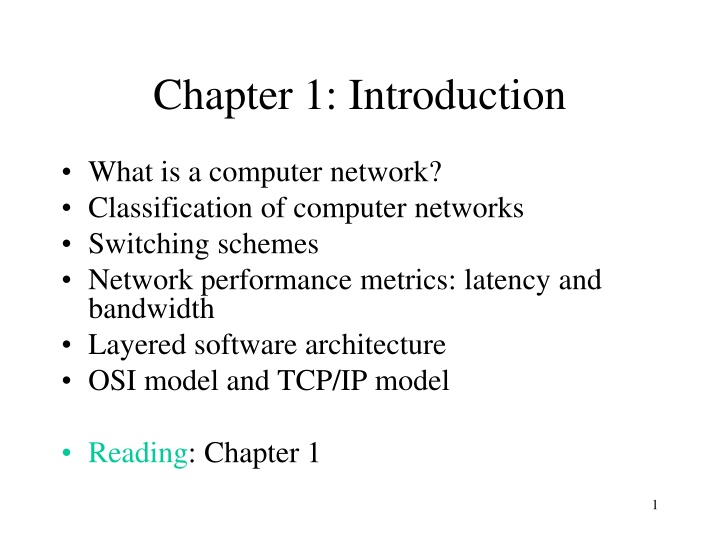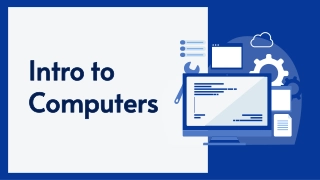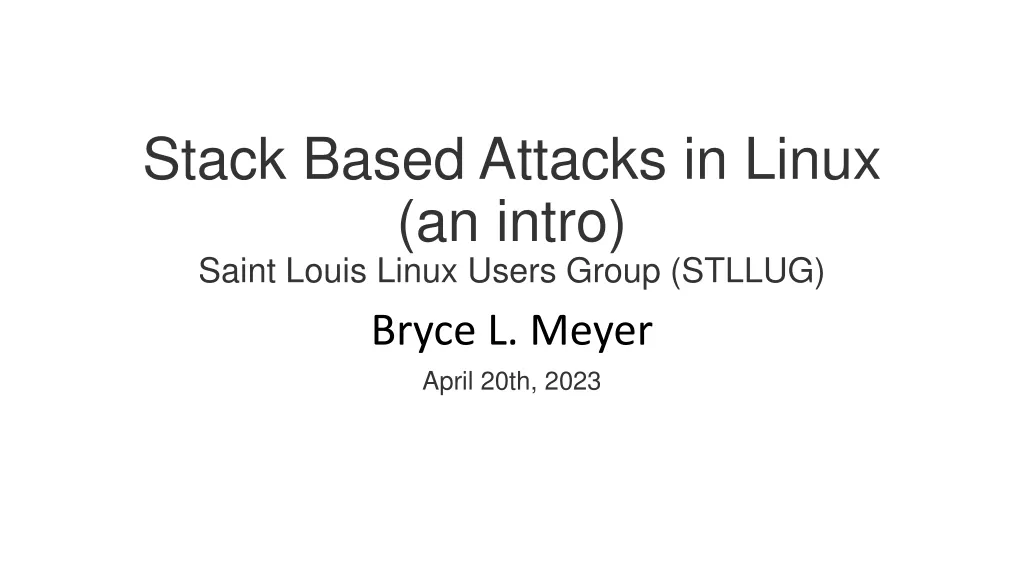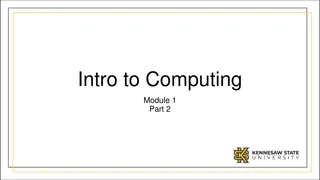
Computer Networks: Introduction and Classification
Explore the fundamentals of computer networks, including their structure, components, and classifications based on scope. Delve into topics like network performance metrics, layered software architecture, and the OSI and TCP/IP models. Learn about different types of networks, from LANs to WANs, and understand how the Internet functions as a collection of interconnected networks.
Download Presentation

Please find below an Image/Link to download the presentation.
The content on the website is provided AS IS for your information and personal use only. It may not be sold, licensed, or shared on other websites without obtaining consent from the author. If you encounter any issues during the download, it is possible that the publisher has removed the file from their server.
You are allowed to download the files provided on this website for personal or commercial use, subject to the condition that they are used lawfully. All files are the property of their respective owners.
The content on the website is provided AS IS for your information and personal use only. It may not be sold, licensed, or shared on other websites without obtaining consent from the author.
E N D
Presentation Transcript
Chapter 1: Introduction What is a computer network? Classification of computer networks Switching schemes Network performance metrics: latency and bandwidth Layered software architecture OSI model and TCP/IP model Reading: Chapter 1 1
What is a Computer Network? Network provides connectivity A set of computers/switches connected by communication links Many possible topologies Many different physical media (links) Coaxial cable, twisted pair, fiber optic, radio, satellite Many different sizes: Local area networks and Wide area networks 2
Elements of a Network Hosts, end-systems pc s, workstations, servers PDA s, phones, toasters running network apps Communication links Point-to-point, multiaccess fiber, copper, radio, satellite Routers, switches, and middleboxes:forward packets (chunks) of data thru network router server workstation mobile local ISP regional ISP company network 3
Classification of Computer Networks Based on physical scope Network-on-chip (NoCs) Within a chip Interconnection networks, system area networks: within one cluster Personal Area Networks (PANs) Local Area Networks (LANs) Campus, building, room Metropolitan Area Networks (MANs) Cover a city up to perhaps 50 miles in length Wide Area Networks (WANs) Cover a larger area typically beyond a city or state 4
LAN EXAMPLE Regional Backbone DENEB 140.222.565 EE subnet 128.226.9.3 128.226.9.14 UNIV-GATE 128.226.9.1 EE-GATE MAIL 128.226.1.1 128.226.1.15 University backbone subnet 128.226.1.0 128.226.1.8 128.226.1.72 SUNS 128.226.3.1 CS subnet 128.226.3.0 128.226.3.5 128.226.3.2 HOME RIGEL ALISTAIR 128.226.3.4 128.226.3.3 5 slip connection
The Internet The Internet : collection of networks and routers that span the world and use the TCP/IP protocols to form a single, cooperative virtual network intranet: connection of different LANs within an organization like the example in the previous example. private may use leased lines usually small, but possibly hundreds of routers may be connected to the Internet (or not), often by firewall 6
Internet Architecture International lines NAP Provider-subscriber relation regional network national network on-line services ISP company ISP university access via modem company LANs 7
NAPs, NSPs, ISPs NSP: National Service Provider (Tier 1 Backbones) Example: AT&T, Sprint , Verizon NAP: Network Access Point National Provider POP NAP NAP NAP NAP Regional Provider National Provider customers 8
Other types of Classifications Based on Technology and Features Using Wireless (Example: Wireless LAN) Using Satellites Using Radio Public Switched Telephone Network The Mobile Telephone System 1G, 2G, 3G, 4G Cable Television Sensor Network 10
Based on traffic type Telephone / voice, PSTN, leased lines Data networks Converged networks 11
Based on Topology Bus based Ring Star Mesh Fully connected, point-to-point, broadcast Ad hoc 12
Bus Topology 5 seconds 12 seconds S1 S3 S2 Hub vs Ring Topology Switch? Star Topology 13
Internets topology: hierarchical topology 14
Internets topology: hierarchical topology Provider-subscriber relationship and peering relationship 15
Based on switching technology (how packets pass a router) Circuit Switched Message Switched Packet Switched Virtual Circuit 16
Circuit Switching Path is set up end-to-end before any data is sent. Then a dedicated path from source to destination is maintained until teardown Connection phase: some setup delay Information transfer phase: transmission delay Disconnection phase: some delay tel tel 17
Timing Diagram Call request Ack Message 18
Message Switching The whole message is sent in a Store-and- Forward No setup or disconnection delay, but queuing delay, overhead in message for routing message message message 19
Packet Switching Message is broken down into packets Each packet is sent in a Store-and-Forward manner Pipelining and multiple paths Retransmission of erroneous packets easier More overhead, fragmentation & reassembly, sequencing Packet s 20
Virtual Circuit Virtual circuit mimics a circuit switched connection (to some extent) by using packet switching technology Virtual circuit is set up, typically by the initial packet(s) Packet size in a VC network is usually much smaller than that in a packet switched network. Subsequent packets (do not have the header) follow the virtual circuit Switches do more work to maintain VC information 21
Latency (delay) and bandwidth Latency (delay) of a link: how much time it takes for one bit to travel from one end of the link to the other end of the link. Typically in the units of milliseconds (ms = 0.001 second) and microseconds (us = 0.000001 second). Sometime latency is treated as overhead and ignored. When sending large messages, this may be reasonable. Bandwidth of a link: how many bits can be injected into the link in one unit of time. 1Mbps: 1,000,000 bits per second 1Gbps: 1,000,000,000 bits per second Example: A link has a latency of 10 micro-second and a bandwidth of 1Gbps, how much time to send a data of 100,000 bits over the link? 22
An example A link has a latency of 10 micro-second and a bandwidth of 1Gbps, how much time to send a data of 100,000 bits over the link? First bit Latency = 10us Time = datasize/bandwidth = 100,000/1Gbps = 100us Last bit Total time = 10us + 100us = 110us 23
A question A D Assuming that A is sending to D a message of size 100,000 bits. Each link has a latency of 10us and a bandwidth of 1Gbps. What is the time to send the message using circuit switching (control packet size = 1 bit)? With message switching? What is the time to send the message using packet switching with packet size 10,000 bits? What is the time to send the message using virtual circuit with packet size of 100 bits? Assume that other times such as packet processing time at switches are negligible. 24
A question A D Assuming that A is sending to D a message of size 100,000 bits. Each link has a latency of 10us and a bandwidth of 1Gbps. What is the time to send the message using circuit switching (control packet size = 1 bit)? With message switching? What is the time to send the message using packet switching with packet size 10,000 bits? What is the time to send the message using virtual circuit with packet size of 100 bits? Assume that other times such as packet processing time at switches are negligible. How to change question parameters to make circuit switching look bad? message switching? packet switching? # of hops, message size, latency, bandwidth, packet size, flit size 25
Circuit switching: good when message duration is long; switch reconfiguration is long. Bad: short message with short reconfiguration time Packet switching: Good for short message, and network resource sharing Virtual circuit: Somewhat similar to packet switching, good for latency, not very good for sharing (useful in over- provisioned network) 26
Use of switching techniques Circuit switching: PTSN, optical networks Message switching: ??? Packet switching: Most computer networks like the Internet Virtual circuit switching: high performance networking (supercomputers, on-chip networks) 27
Summary What is a computer network? Typical components of a computer network? Classify networks by physical scope Classify networks by switching scheme Describe circuit switching, packet switching, and virtual circuit switching Define latency and bandwidth Revisit the question in the last class when can a packet be forwarded in the middle router. 28
Layered Architecture Why layering? Network software is very complex: naming or addressing, fragmentation/reassembling of packets, multiplexing of packets, forwarding and routing, handling error, handling speed mismatch, handling congestion, How to deal with complex software? Divide-and-conquer The layered model simplifies the design Heterogeneity in the network environment Different machines, switches, links, interfaces from different vendors. Solution: break up the system into different layers. Each layer provides an abstraction for its upper layer. E.g. connections: modem, Ethernet, Token ring--> a link in the second layer. Third layer will then only be concerned with links. In OS, we have device drivers. 29
Layering is a useful abstraction Another example of abstraction: programming languages. Machine language (low level, works only on one machine) Assembly language (higher level, works for several machines) C++ (works on almost all machines). Differences between layering in the network software and layering in programming language? Programming language: interface between upper layer and lower layer Network software: Interface between upper layer and lower layer Flow of information up and down Interface between peers in the same layer. 30
Layered Architecture Layering simplifies the architecture of complex system Layer N relies on services from layer N-1 to provide a service to layer N+1 Interfaces define the services offered Service required from a lower layer is independent of it s implementation Layer N change doesn t affect other layers Information/complexity hiding Similar to object oriented methodology Layer N+1 Protocol Layer N Protocol 31
Some terminology: entity: an active element in a layer (machine, procedure, process, I/O chip). Peer entities: entities on the corresponding layers on different machines. Exchange well-defined pieces of information Message, packet, frame: structured sequence of bits that are exchanged Protocol: a set of coordination rules governing the communication between two peer entities. Each layer has a protocol -- layer n protocol. Service interface: the interface between upper layer and lower layer. Upper layer: service user. Lower layer: service provider. 32
Service types: connection-oriented service & connectionless service -- order of packets Connection-oriented -- like the telephone. Establish the connection, use the connection, then release the connection. Even when multiplexed, minimal header information The packets received are in the same order as the packets sent. Connectionless (datagram) -- like the postal system. Each message carries its destination s address and is routed to the destination independently. The packets received may not be in the same order as the packets send. reliable and unreliable loss or no loss of packets reliable: all packets sent are received correctly unreliable: packets sent may not be received 33
Four combinations of service types: Reliable connection-oriented Reliable connectionless Unreliable connection-oriented Unreliable connectionless Example: send 1 2 3 4 5 receive: 1 2 3 4 5 4 1 3 2 5 4 2 1 2 4 2 3 1 4 1 Why not just reliable connection-oriented? too costly to support connection-oriented services at all layers. Sometimes applications may not need such service: telephone: unreliable connection-oriented. video streaming: late packets are useless 34
Elements of a protocol: Rules by which each network entity at the same layer on different devices communicate syntax: what is a valid message in terms of structure? semantics: what is a valid message in terms of meaning? Is timing important?: relative order of messages. Network architecture: a set of layers/protocols/service interfaces that define how functionality is divided up. 35
Protocols and Services Protocols are used to implement services Peering entities in layer N provide services by communicating with each other using the service provided by layer N-1 Logical vs physical communication 36
Reference models: ISO: International Standards Organization OSI: Open Systems Interconnection. Seven layers ISO/OSI reference model: Application Application Presentation Presentation Session Session Transport Transport Network Network Network Data Link Data link Data link Physical Physical Physical 37
Physical layer: how to transfer bits correctly conversion of bits into signals, what is 0, 1? How long does a bit lasts? How many pins in a connection? Cable and connector to connect devices How to send 0 s and 1 s Physical layer protocol: (1) physically connects two devices; and (2) when the sending device sends a bit stream (e.g. 0100110100), the receiving device would receive what was sent. 38
Data link layer: how to transfer frames correctly Send frames (a unit of data that has a logical meaning) frame .vs. bit stream, why frame? Deal with errors, manipulate based on structure. Reliably transfer frames over a link, how to identify a frame, error control, speed mismatch between senders and receivers. Divided into Media Access Control (MAC) and Logical Link Control (LLC) layers Computer A, B, and C are directly connected by a link . transmit formatted data (Ethernet frame) Capable of detecting transmission errors Must decide when a computer can transmit data: media access control 39
Data link layer Below data link layer, the functionality is usually done in the hardware. Above data link layer, the functionality is usually done in the software. Ethernet (data link layer) service interface would be something like this: Eth_send (Eth_dst, data, ); Eth_recv(Eth_src, data, ); // such routines form the service interface For two machine connected over the same Ethernet domain, software can call the service interface functions to communicate. Eth_dst Eth_src Eth_send Eth_recv 40
Network layer: how to send a packet to the destination (hop by hop)? directly connected domains cannot be very large. Larger networks are formed with routers separating directly connected domains. Forwarding, routing, congestion control, format conversion (internetworking), accounting, etc Service interface: ip_send(ip_dst, data), ip_recv(ip_src, data) E.g. on DENEB (128.226,9,14), call ip_send(128.226.3.5, data) 41
E.g. on DENEB (128.226.9.14), call ip_send(128.226.3.5, data) ip_send(128.226.3.5,data) ip_recv(128.226.9.14,data) Network layer Data link layer Physical layer Network layer Data link layer Physical layer Network layer Data link layer Physical layer Network layer Data link layer Physical layer DENEB EE-GATE SUNS RIGEL EE-GATE network layer: Eth_recv(Eth(DENEB), XXX); 128.226.9.14 is not in my network, route to SUNS Eth_send(Eth(SUNS), 128.226.9.14+data) EE-GATE network layer: Eth_recv(Eth(EE-GATE), YYY); 128.226.9.14 is in my network, send to RIGEL Eth_send(Eth(RIGEL), 128.226.9.14+data) RIGEL network layer Eth_recv(Eth(SUNS), YYY); I am 128.226.9.14; Pass data up ip_recv returns DENEB network layer: Eth_send(Eth(EE-GATE), 128.226.9.14+data) Original header+data 42
Transport: end to end communication. First layer that runs at end points but not at intermediate hops. Connection establishment/management/termination, error control/flow control/multiplexing Reliability, probing data rate, deal with congestions, etc Service interface: tcp_send(ip+port, data), tcp_recv(ip+port, data); tcp_recv(XXX:YYY,data) tcp_send(128.226.3.5:80,data) Transport layer Transport layer Network layer Data link layer Physical layer Network layer Data link layer Physical layer Network layer Data link layer Physical layer Network layer Data link layer Physical layer DENEB EE-GATE SUNS RIGEL DENEB transport layer: ip_send(128.226.3.5, 80+data) RIGEL transport layer ip_recv(XXX, YYY); Data is for port 80; Give data to httpd (80) This is the basic end-to-end communication, the actual transport layer protocol is much more complex. 43
Session layer: allows users to establish session, enhanced services. Checkpointing. Presentation layer: provides general solutions to users. Compression, syntax conversion, cryptography Application layer: variety of protocols that are commonly used. Email, FTP, Telnet: these are all network applications that call tcp_send, and tcp_recv routines to perform communications. Functionality of the network software are partitioned into different layers. Flow control (speed mismatch between two machines): data link and transport Routing: network layer addressing: almost all layers ... 44
Data transmission using the OSI model: data Application application presentation presentation session session transport transport network network network data link data link data link physical physical physical AH data . . . DH NH TH SH PH AH Data Upper layer protocol header becomes data at the lower level. Assuming 100Mbps Ethernet is used to send 30 bytes (user) data, let AH=PH=SH=TH=NH=DH=10 bytes, what is the maximum throughput the application can observe? 45
OSI model was not very successful!! The TCP/IP protocols became the de facto network software standard. From the TCP/IP protocols, people derived the TCP/IP reference model. TCP/IP reference model: Application layer (Telnet, FTP SMPT, DNS, NNTP, HTTP) Transport layer (TCP, UDP) Internet layer (IP) Host to Network layer (Ethernet, FDDI, X.25) 46
TCP/IP reference model: Application layer (Telnet, FTP SMPT, DNS, NNTP, HTTP) No session and presentation layers. Interface socket programming: (TCP_send, TCP_recv, UDP_send, UDP_recv) Transport layer (TCP, UDP) Allow entities at end hosts to communicate TCP (transmission control protocol): reliable connection-oriented UDP (user datagram protocol): unreliable connectionless Interface: (IP_send, IP_recv) Internet layer (IP) A packet switching network based on connectionless communication. Hosts send packets into the network and then the packets travel independently to their destinations. Format conversion: for different networks. Packet format and protocol: IP Interface network dependent, Ethernet: (Eth_send, Eth_recv) Host to Network layer (Ethernet, FDDI, X.25) Undefined, rely on the existing technology - must be able to send IP packets over this layer. 47
Encapsulation & Decapsulation Get/Infocom/index.html HTTP/1.0 TCP (20) Get/Infocom/index.html HTTP/1.0 IP (20) TCP (20) Get/Infocom/index.html HTTP/1.0 Ethernet (14) IP (20) TCP (20) (4) Get/Infocom/index.html HTTP/1.0 Ethernet header exclude preamble and start frame of 8 bytes 48
TCP/IP model vs. OSI model: similarity: based on the concept of the stack of independent protocols. Similar functionality Differences: The concepts of services/interfaces/protocols are clear in the OSI model, but not as much in the TCP/IP model. The OSI model was devised before the protocols were invented, it misses some important issues. The TCP/IP model was devised after the protocols were designed, so the model may not fit other protocols. Difference in the network layer: TCP/IP: only connectionless (the IP protocol) OSI: connectionless and connection-oriented. 49
The five-layer hybrid model: Application Transport Network Data Link Physical 50










